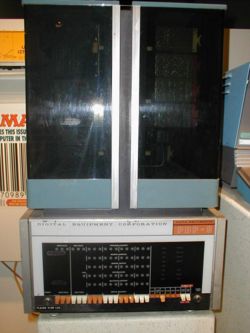Difference between revisions of "PDP-8"
m (rm bad cat) |
(Give basic clock) |
||
| (9 intermediate revisions by 3 users not shown) | |||
| Line 11: | Line 11: | ||
| year discontinued = 1969 | | year discontinued = 1969 | ||
| architecture = [[PDP-8 architecture|PDP-8]] | | architecture = [[PDP-8 architecture|PDP-8]] | ||
| − | | physical address = | + | | physical address = 32k words (requires optional Type 183) |
| − | | virtual address = | + | | virtual address = 4k words |
| − | | design type = [[clock]]ed random [[logic]] | + | | design type = [[clock]]ed random [[logic]] |
| − | | clock speed = | + | | clock speed = 1.333 MHz |
| + | | cycle time = 1.5 μseconds | ||
| memory speed = 1.5 μseconds | | memory speed = 1.5 μseconds | ||
| memory mgmt = bank select | | memory mgmt = bank select | ||
| Line 31: | Line 32: | ||
}} | }} | ||
| − | The '''PDP-8''' was [[Digital Equipment Corporation|DEC]]'s major breakthrough, and now considered the first successful [[minicomputer]]. It was, by a significant amount, the cheapest computer yet made at the time. | + | The '''PDP-8''' (now often known as a '''Straight 8'''; the name dates from the late 60's, apparently adopted to allow disambiguation), the first model of the [[PDP-8 family]], was [[Digital Equipment Corporation|DEC]]'s major breakthrough, and now considered the first really successful [[minicomputer]]. It was, by a significant amount, the cheapest computer yet made at the time. |
The PDP-8 was constructed with discrete [[transistor]]s, packaged into DEC's [[FLIP CHIP]] technology. It could perform an addition to the [[accumulator]] in 3.0 μseconds, and a 12 by 12 bit multiplication with 24 bit result in 15 μseconds (average; range 9 to 21), using the optional math extension hardware (below). | The PDP-8 was constructed with discrete [[transistor]]s, packaged into DEC's [[FLIP CHIP]] technology. It could perform an addition to the [[accumulator]] in 3.0 μseconds, and a 12 by 12 bit multiplication with 24 bit result in 15 μseconds (average; range 9 to 21), using the optional math extension hardware (below). | ||
| Line 39: | Line 40: | ||
Options included: | Options included: | ||
| − | * Type 183 Memory Extension Control, which was needed to support more than | + | * Type 183 Memory Extension Control, which was needed to support more than 4k [[word]]s of memory |
* Type 184 Memory Module | * Type 184 Memory Module | ||
* Type 188 Memory Parity | * Type 188 Memory Parity | ||
| Line 49: | Line 50: | ||
*[[OS/8]] | *[[OS/8]] | ||
*[[TSS/8]] | *[[TSS/8]] | ||
| + | *COS-310 | ||
== Emulators == | == Emulators == | ||
| Line 55: | Line 57: | ||
*[[SIMH]] | *[[SIMH]] | ||
| + | |||
| + | == Application software/Simulation software == | ||
| + | |||
| + | Mention in this video regarding a PDP-8 screen running J.H. Conways game of life: | ||
| + | |||
| + | * [https://www.youtube.com/watch?v=R9Plq-D1gEk Inventing Game of Life - Numberphile] | ||
{{Nav PDP-8}} | {{Nav PDP-8}} | ||
Revision as of 11:57, 25 August 2019
This article is about the first PDP-8, which had that name without a model suffix. For information about PDP-8's in general, see PDP-8 family.
| PDP-8 | |
 An original, transistorized PDP-8 | |
| Manufacturer: | DEC |
|---|---|
| Architecture: | PDP-8 |
| Year Introduced: | 1965 |
| Year Discontinued: | 1969 |
| Form Factor: | minicomputer |
| Word Size: | 12 bits |
| Logic Type: | DTL |
| Design Type: | clocked random logic |
| Clock Speed: | 1.333 MHz |
| Cycle Time: | 1.5 μseconds |
| Memory Speed: | 1.5 μseconds |
| Physical Address Size: | 32k words (requires optional Type 183) |
| Virtual Address Size: | 4k words |
| Memory Management: | bank select |
| Bus Architecture: | Negative I/O Bus |
| Predecessor(s): | PDP-5 |
| Successor(s): | PDP-8/I |
| Price: | US$18,500 |
The PDP-8 (now often known as a Straight 8; the name dates from the late 60's, apparently adopted to allow disambiguation), the first model of the PDP-8 family, was DEC's major breakthrough, and now considered the first really successful minicomputer. It was, by a significant amount, the cheapest computer yet made at the time.
The PDP-8 was constructed with discrete transistors, packaged into DEC's FLIP CHIP technology. It could perform an addition to the accumulator in 3.0 μseconds, and a 12 by 12 bit multiplication with 24 bit result in 15 μseconds (average; range 9 to 21), using the optional math extension hardware (below).
Options
Options included:
- Type 183 Memory Extension Control, which was needed to support more than 4k words of memory
- Type 184 Memory Module
- Type 188 Memory Parity
- Type 182 Extended Arithmetic Element, which supported hardware integer multiplication and division, multi-bit double-word shifts, and normalization
Operating Systems
The PDP-8 could run various operating systems including:
Emulators
There are various emulators for PDP-8 systems including:
Application software/Simulation software
Mention in this video regarding a PDP-8 screen running J.H. Conways game of life:
| v • d • e PDP-8 Computers, Software and Peripherals |
|---|
| PDP-8s: PDP-5 • PDP-8 • LINC-8 • PDP-8/S • PDP-8/I • PDP-8/L • PDP-12 • PDP-8/E • PDP-8/F • PDP-8/M • PDP-8/A
Workstations: VT78 Also: PDP-8 family • PDP-8 architecture • PDP-8 Memory Extension units |